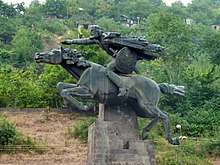Davit Bek
| Davit Bek | |
|---|---|
 A monument to Davit Bek in Kapan | |
| Born |
unknown date in the 17th century Chavndour, district of Kovsakan, province of Syunik, Safavid Armenia[1] |
| Died | 1728 |
| Allegiance | Armenian national movement |
| Years of service | 1722-1728 |
| Rank | Supreme commander |
Davit Bek or David Beg (Armenian: Դավիթ Բեկ; died 1728) was an Armenian military commander and one of the most prominent military figures of the Armenian liberation movement of the 18th century.
After the fall of the Safavids in 1722, Davit Bek established himself as leader of the defenses of the local Armenians of Syunik and Kapan during the Ottoman Turkish invasion and the attacks of the local Muslim tribes.[2] Davit was successful in preventing the various Muslim tribes from making proper territorial gains. In 1727, in order to put a halt to the Ottoman approach in the area, king Tahmasp II appointed Davit as the governor of the area, and gave him the right to administer the area as a vassal Armenian principality under Iranian control.[3][4]
In 1726-28, the local Armenians under the leadership of Davit Bek went to war with Turkish armies at Halidsor and had showed great military competence and valor by defeating them easily.[5]
Biography
Little is known about Davits early life.[6] He was of noble lineage, stemming from princes of Chavndour (district of Kovsakan in southeastern Syunik), and had served the vali (i.e. viceroy)/king of Kartli, Vakhtang VI (Hosaynqoli Khan).[2]
The Armenian meliks, local feudal words, had long been recognized as governors of the area by the Iranian shahs.[2] In 1722 however, the Safavid state collapsed. Numerous Muslim tribes in the area were now competing for influence in the area. Peter the Great's steady advance south towards the Caucasus during the Russo-Persian War of 1722-1723 with a massive 30,000 man army had revived hope among the Armenians and Georgians that Russian arms could help clear the region from Muslim dominion.[7] Muslim misrule in the regions of Kapan and Artsakh (Karabakh) eventually provoked the Armenian meliks in 1722 to request military aid from Vakhtang.[8][9]
Vakhtang agreed to aid the meliks; he sent Davit Bek, reportedly one of his most capable officers, together with some 2,000 Armenian soldiers.[9] Davit made the fort of Halidzor his base of operations.[9] With the support of the local peasants and the meliks, Davit managed to defend the Armenian-inhabited areas from the Muslim tribes.[2] Even though initially Davit's main enemy were the Iranians, he soon came to the conclusion that it was the Ottoman Turks who posed a much greater danger.[9] In 1727, in order to put a halt to the Ottoman approach in the area, king Tahmasp II appointed Davit as the governor of the area, and gave him the right to administer the area as a vassal Armenian principality under Iranian control.[3][4]
Encouraged by his successes, many Armenians raised the banner of revolt against the Muslims and joined Davit's ranks. The meliks of Karabakh soon joined the cause for national liberation, lending Davit Bek men and materiel; Avan Yuzbashi, a military commander from Shusha who was to become one of Davit Bek's close supporters, contributed 2,000 men to the war effort.
After Davit Bek's death in 1728, command of the area passed to Mkhitar Sparapet.[2]
Popular culture
In 1944, at the height of World War II, David Bek the movie was filmed by director Hamo Beknazarian with Hrachia Nersisyan starring as Davit Bek. In 1978 Armenfilm in association with Mosfilm produced another movie about the efforts of Davit Bek and Mkhitar Sparapet called Star of Hope. Davit Bek was portrayed by Georgian actor Edisher Magalashvili.
Bek was the subject of an opera, David Beg, composed by Armen Tigranian.
See also
References
- ↑ Agop Jack Hacikyan, Gabriel Basmajian, Edward S. Franchuk. The Heritage of Armenian Literature: From the eighteenth century to modern times Wayne State University Press, 2005 ISBN 978-0814332214. page 22
- 1 2 3 4 5 Adalian 2010, pp. 250-251.
- 1 2 Adalian 2010, pp. xlv, 250-251.
- 1 2 Nalbandian 1963, p. 23.
- ↑ Visions of Ararat: writings on Armenia - Page 24, Christopher J. Walker
- ↑ Bournoutian, George (1997). "Eastern Armenia from the Seventeenth Century to the Russian Annexation" in The Armenian People From Ancient to Modern Times, Volume II: Foreign Dominion to Statehood: The Fifteenth Century to the Twentieth Century. Richard Hovannisian (ed.) New York: Palgrave Macmillan. p. 88. ISBN 1-4039-6422-X.
- ↑ Hewsen, Robert (2001). Armenia: A Historical Atlas. Chicago: Chicago University Press. pp. 163–165. ISBN 0-226-33228-4.
- ↑ Bournoutian. "Eastern Armenia", p. 88.
- 1 2 3 4 Bournoutian 2001, p. 408.
Sources
- Adalian, Rouben Paul (2010). Historical Dictionary of Armenia (2 ed.). Scarecrow Press. ISBN 978-0810874503.
- Bournoutian, George A. (2001). Armenians and Russia, 1626-1796: A Documentary Record. Mazda Publishers. ISBN 978-1568591322.
- Nalbandian, Louise (1963). The Armenian Revolutionary Movement: The Development of Armenian Political Parties Through the Nineteenth Century. University of California Press. ISBN 978-0520009141.
Further reading
- "The Armenian Rebellion of the 1720s and the Threat of Genocidal Reprisal", Armen Ayvazyan
- Harutyunyan, P. T. The liberation movement of Armenian people in the first quarter of the XVIIIth century. Moscow, 1954.